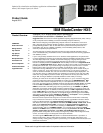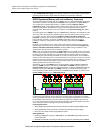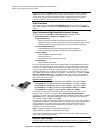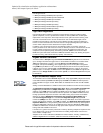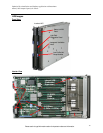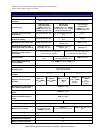
Optimized for virtualization and database applications with maximum
memory and compute capacity in a blade
Please see the Legal Information section for important notices and information.
4.
• Most HS/LS/JS/QS blade servers ever released by IBM are supported in every BladeCenter chassis
ever released, going back to 2002
3
. Every switch module released by IBM is equally compatible.
(Ask HP and Dell how far back their compatibility goes.)
• A blade server has access to as many as 10 communication switches/bridges in a BladeCenter
H or 8 in a BladeCenter HT chassis. (Up to 4 switches in a BladeCenter E, S, or T chassis.) And the
switches can be Ethernet, iSCSI, SAS, InfiniBand, Fibre Channel, or anything else designed and
ServerProven
®
for BladeCenter use. Switches, bridges and interface cards are currently available
from such vendors as Brocade, Cisco, Intel, McData, Nortel, QLogic, Cisco Topspin and others, in
addition to IBM.
Manageability
• The HX5 blade server includes an Integrated Management Module (IMM) to monitor server
availability, perform Predictive Failure Analysis, etc., and trigger IBM Systems Director alerts. The
IMM performs the functions of both the Baseboard Management Controller (BMC) of earlier
systems, and the Remote Supervisor Adapter II, as well as remote presence/cKVM.
• Each BladeCenter chassis includes an Advanced Management Module to provide additional
systems management capabilities, including Web-based out-of-band control; virtual floppy and CD-
ROM support; latest OS failure screen capture; LDAP and SSL support; and remote redirection of
video, text, keyboard and mouse.
• Integrated industry-standard Unified Extensible Firmware Interface (UEFI) next-generation BIOS.
New capabilities include:
Human readable event logs – no more beep codes
Complete setup solution by allowing adapter configuration function to be moved into UEFI
Complete out-of-band coverage by the Advance Settings Utility to simplify remote setup
• Integrated industry-standard IPMI 2.0 support works with the IMM to alert IBM Systems Director to
anomalous environmental factors, such as voltage and thermal conditions. It also supports highly
secure remote power control.
• Integrated Trusted Platform Module (TPM) provides a highly secure start-up process from power-
on through hand-off to the operating system boot loader. ACPI support is provided to allow ACPI-
enabled operating systems to access the security features of this module. (TCG V1.2-compliant.)
• IBM Systems Director Active Energy Manager, an IBM-exclusive, is designed to take
advantage of new system power management features, by monitoring actual power usage and
providing power consumption capping features. More accurate power usage data helps with data
center construction planning and the sizing of power and cooling needs, as well as allowing you to
use available power more efficiently.
• The HX5 supports remote presence/concurrent KVM (cKVM) and concurrent media (cMedia)
access by multiple administrators at once, via the IMM.
• IBM Systems Director is included for proactive systems management and works with both the
blade’s internal IMM and the chassis’ management module. It comes with a portfolio of tools,
including IBM Systems Director Active Energy Manager, Service and Support Manager, and
others. In addition, IBM Systems Director offers extended systems management tools for additional
server management and increased availability. When a problem is encountered, IBM Systems
Director can issue administrator alerts via e-mail, pager, and other methods.
Availability and Serviceability
• BladeCenter chassis are designed for operation with greatly reduced potential for single points
of failure. Most aspects of operation, from blade servers to communication modules, to
management modules, to power and blower modules, are hot-swappable. The midplane
connections are redundant and the other features can be made so, when used in pairs.
• Fast PC3-10600 DDR3 ECC memory offers multiple layers of Active Memory protection, including
Chipkill error correction, Memory ProteXion (redundant bit steering), memory scrubbing, memory
rank sparing, and memory mirroring for high availability
• HX5 blade servers support the use of Chipkill-enabled ECC (error checking and correcting)
memory. Chipkill memory can be up to 16X better than standard ECC memory at correcting some
types of memory errors. This can help reduce downtime caused by memory errors.
• Solid-state drives offer up to triple the availability (MTBF rates) of conventional SAS HDDs. This
can lessen the need for redundant drives.
• IPMI 2.0 supports highly secure remote system power on/off using data encryption. This allows an
administrator to restart a server without having to visit it in person, saving travel time and getting the
server back up and running quickly and securely.
3
Some older chassis may require power module and management module upgrades.



